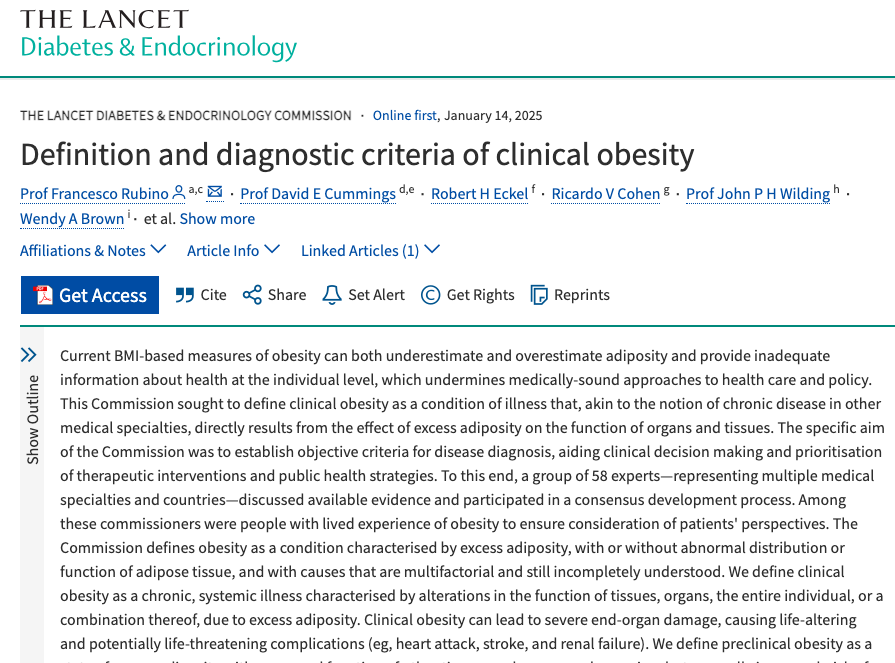Redefining Obesity: The Lancet Commission’s New Diagnostic Criteria & The Science Behind It

For decades, the definition of obesity has been a topic of intense debate, often oversimplified by a single number: BMI. Now, a groundbreaking consensus statement from The Lancet Commission on the Definition and Diagnosis of Clinical Obesity is redefining how we understand and diagnose this complex condition. Endorsed by the World Obesity Federation and 75 other leading medical organisations, this crucial report provides a clearer framework, distinguishing between pre-clinical obesity (a risk stage) and clinical obesity (a true disease stage). This shift fundamentally changes the science behind obesity diagnosis and its implications for personalised care.
What Was It? Refining Obesity Classification
The Lancet Commission on the Definition and Diagnosis of Clinical Obesity, comprising 56 international experts, developed this pivotal consensus statement to refine how obesity is classified. Officially endorsed by the World Obesity Federation and 75 other medical organisations, the statement provides a much clearer distinction between:
- Pre-clinical obesity: Characterised by excess body fat but no associated organ dysfunction or activity limitations. This is considered a risk stage.
- Clinical obesity: Defined by excess body fat accompanied by organ dysfunction or activity limitations. This is now recognised as a disease stage.
This key distinction is vital for accurate diagnosis and tailoring appropriate interventions.
Why Was It Needed? The Spectrum of Obesity & Its Implications
In medicine, many conditions exist on a spectrum – consider the progression from pre-diabetes to diabetes. Obesity is no different. There has long been considerable debate about when excess body fat is simply a risk factor versus when it becomes a disease. This distinction carries significant implications for:
- Risk factor modification versus medical treatment: Guiding whether lifestyle changes or direct medical interventions are appropriate.
- Funding and access to healthcare: Influencing policy and provision for different stages of the condition.
The consensus statement aims to align obesity classification with other complex medical conditions, ensuring a more precise framework for diagnosis and, crucially, for guiding medical weight loss options and other interventions.
What’s Changing? New Diagnostic Criteria Beyond BMI
The Lancet Commission’s report introduces several significant changes to how obesity is assessed and diagnosed:
- BMI is now primarily a screening tool: It is no longer considered a definitive diagnostic measure on its own.
- Broader diagnostic criteria: Diagnosis can now include measures like waist circumference, waist-to-height ratio, or more direct body fat measurements, offering a more holistic view.
- Recognition of health status beyond size: The statement explicitly acknowledges that some individuals with excess body fat may remain metabolically and functionally well, reinforcing the principles of weight-neutral healthcare.
These changes highlight a nuanced understanding of body composition and health.
Considerations for Clinicians: Implementing the New Framework
Implementing this new, detailed classification of obesity will naturally bring new considerations for healthcare professionals. Clinicians will need to consider:
- Integrating new assessment criteria: How to effectively incorporate waist circumference, waist-to-height ratio, and other measures into routine practice.
- Funding implications for pre-clinical obesity: Navigating how early interventions for the risk stage will be supported.
- Balancing early intervention with avoiding overdiagnosis: Ensuring appropriate care is provided without medicalising normal variations in body size.
The real-world impact of this consensus statement will ultimately depend on its thoughtful and ethical implementation in clinical settings, especially for fields like Obesity physio which play a vital role in management.
Towards More Precise and Patient-Centred Care
The Lancet Commission’s consensus statement represents a significant step forward in understanding the science behind obesity and its clinical management. By refining the definition and diagnosis of clinical obesity, it moves us towards a more nuanced, evidence-based, and ultimately more patient-centred approach to healthcare. This shift empowers clinicians to provide more targeted interventions, ensuring that care truly aligns with an individual’s health status, beyond simplistic measurements.
Seeking Expert Support for Obesity Management?
Understanding the complexities of clinical obesity and its management requires expert guidance. At Laneways Rehab, our approach is rooted in the latest research and a commitment to evidence-based care. We offer specialised support, including exercise program in conjunction with weight management interventions and comprehensive physiotherapy tailored to individual needs.
